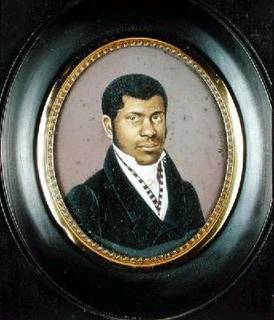Pierre Toussaint
In 1996, Pope John Paul II bestowed the title of “Venerable” on Pierre Toussaint. Two years later, Pierre Toussaint Square was named for him. This man, who was brought to New York as a slave in 1787, may soon become the first Haitian saint.
Toussaint was raised as a slave in the household of Jean Berard, a family of devout Catholics who taught him both reading and writing. When the family fled the revolution on their island, they brought Pierre and his sister Rosalie with them. Pierre was immediately apprenticed to a hairdresser, and went on to become one of the best in the city. At that time, wealthy women would spend $1000 a year on their hairdos, so Toussaint was able to make very good money. But what he did with his money is more extraordinary.
When his master died, Toussaint supported his mistress. He bought his sister’s freedom rather than his own, so that she could marry and bear free children. He bought his future wife’s freedom and helped many other slaves to buy theirs. He donated money to his beloved Church, to ministers and nuns, to orphans white and black, and to countless other causes. Not only did he donate money, but he also visited the sick and nursed them during yellow fever epidemics when no one else dared to.
Upon his death in 1853, the city mourned him, the papers eulogized him, and the great Revolutionary leader General Philip Schuyler said of him, “I have known Christians who were not gentlemen or gentlemen who were not Christians--but one man I know who is both--and that man is Black.”
This entry contributed by
Curriculum Concepts International
Related Media
Video

|
Dowoti Desir, Director of The Malcolm X and Dr. Betty Shabazz Memorial and Educational Center, describes the personal and historical significance of marking the African Burial Ground Memorial and other historical sites in downtown Manhattan.
|

|
Dowoti Desir, Executive Director of The Malcolm X and Dr. Betty Shabazz Memorial and Educational Center, talks about Pierre Toussaint as a Haitian immigrant and as a politically significant figure from his earliest days as a hairdresser in New York.
|
Images

|
In 1953, this marker was laid in Toussaint’s honor at St. Patrick’s Old Cathedral at 263 Mulberry Street. His remains were later moved to the crypt below the altar of the current St. Patrick’s Cathedral.
|

|
When Pierre Toussaint was brought to New York from Haiti, he was enslaved. And yet his accomplishments in New York were so remarkable that he may become the first Haitian declared a saint by the Catholic Church.
|
